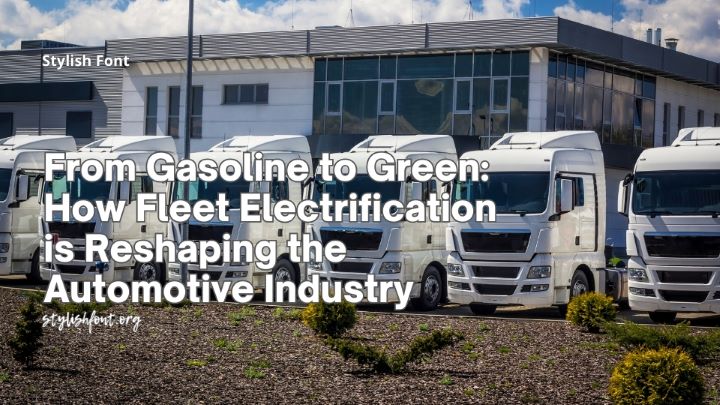Key Takeaways
- Fleet electrification is becoming increasingly crucial for environmental sustainability and cost efficiency.
- Several benefits come with electrifying a fleet, including reduced maintenance costs and enhanced energy security.
- Challenges such as infrastructure and initial costs must be addressed.
- The future of fleet electrification looks promising with ongoing advancements in technology.
Introduction to Fleet Electrification
Turning traditional vehicle fleets into eco-friendly, cost-efficient powerhouses. Companies and organizations increasingly adopt EV fleet charging solutions to meet sustainability goals and reduce operational costs. As concerns about climate change intensify, the shift to electric vehicles (EVs) is more critical than ever. This transition responds to environmental concerns and a strategic move to future-proof businesses in an evolving regulatory landscape.
Historically, fleets have relied heavily on diesel and gasoline-powered vehicles. Yet, the progress in battery technology and the increasing presence of EVs have cleared the path for extensive acceptance. Electric cars’ increasing performance and affordability make it a suitable time for fleet operators to consider switching. This article explores fleet electrification’s benefits, challenges, and prospects, providing insights into this significant industry shift.
Benefits of Electrifying Your Fleet
Environmental Impact
Switching to electric vehicles can significantly reduce greenhouse gas emissions and improve air quality. Conventional vehicles release high carbon dioxide levels, a significant cause of climate change. EVs produce zero tailpipe emissions, helping to combat climate change and improve public health. Companies that adopt electric fleets are better positioned to meet environmental regulations and sustainability goals. By reducing emissions, businesses can also avoid potential fines and penalties associated with non-compliance, further reinforcing the economic advantages of EV adoption.
Cost Savings
Electrifying a fleet can lead to substantial cost savings over time. Electric vehicles typically have lower fuel costs compared to their gasoline counterparts. Electricity normally costs less and has a more consistent price compared to gasoline or diesel, resulting in more predictable and reduced operational costs. Additionally, EVs have fewer moving parts, reducing the frequency and maintenance cost. For instance, electric motors are less prone to wear and tear than internal combustion engines, leading to fewer breakdowns and lower repair bills. These savings can accumulate significantly over the vehicle’s lifespan, making the initial higher investment more palatable. Companies also benefit from potential tax credits and incentives to encourage electric vehicle adoption, further mitigating costs.
Enhanced Energy Security
Sustainable energy sources can fuel electric cars. This shift can protect companies from the volatility of oil prices and contribute to national energy independence. By investing in on-site renewable energy sources, businesses can further insulate themselves from energy market fluctuations and ensure a continuous supply for their fleet operations. This stability secures operational continuity and aligns with broader energy strategies focused on long-term sustainability and resilience against future energy crises.
Challenges in Fleet Electrification
Infrastructure Requirements
One of the main challenges in fleet electrification is the need for adequate charging infrastructure. Businesses must install charging stations at their facilities, which can be costly and time-consuming. Furthermore, more than the current public charging network may be required to meet large electric fleets’ demands, necessitating additional infrastructure investment. Establishing a robust charging network requires careful planning and coordination with utility providers to ensure the electrical grid can support increased demand. Companies must also consider the logistics of charging, such as minimizing downtime and scheduling charges during off-peak hours to reduce costs and strain on the grid.
Initial Investment Costs
While electric vehicles offer long-term cost savings, the initial investment can be high. The purchase price of EVs is usually higher than that of conventional cars, and businesses must also invest in charging equipment. However, various incentives and grants are available to offset these costs, making the transition more feasible. Governments and utilities often provide rebates,
Tax credits are provided as monetary rewards to promote the usage of electric cars and the required support system. Properly leveraging these programs can significantly reduce the economic burden of transitioning to an electric fleet, making the upfront investment more justifiable given the long-term benefits.
Technological Advances Driving Fleet Electrification
Battery Technology
Recent developments in battery technology are increasing the feasibility and cost-effectiveness of electric vehicles. Innovations such as solid-state batteries offer higher energy densities and faster charging times. These improvements extend the driving range of EVs and reduce the overall cost of ownership, making them more attractive for fleet operators. Solid-state batteries are recognized for their improved safety qualities, which minimize the likelihood of overheating and fires compared to conventional lithium-ion batteries. Continual advancements in battery recycling technologies are also helping to address environmental concerns related to battery disposal, making the lifecycle of EVs more sustainable.
Charging Solutions
Developments in charging technology are also facilitating fleet electrification. Rapid charging stations can quickly recharge an electric car in just a few minutes, thus significantly decreasing the amount of time the vehicle is out of commission. Wireless charging and vehicle-to-grid technology also offer new ways to optimize energy use and improve charging efficiency. Wireless charging removes the necessity for physical cables, streamlining the charging process and enhancing convenience. Vehicle-to-grid technology enables electric vehicles to supply electricity back to the grid when there is high demand, creating extra earnings and improving grid reliability. Such innovations are critical in creating an efficient and user-friendly charging ecosystem that supports the needs of electric fleets.
Real-Life Success Stories
Several companies have successfully transitioned to electric fleets, showcasing the benefits and feasibility of this shift. For example, logistics giant UPS has committed to purchasing over 10,000 electric delivery trucks to reduce its carbon footprint and operational costs. Their commitment to an electric fleet highlights the possibility of substantial savings and positive environmental impacts. Similarly, municipalities worldwide are adopting electric buses to provide cleaner and more efficient public transportation. Cities like Los Angeles and London plan to electrify their bus fleets, significantly reducing urban air pollution and improving public health. More examples can be found on platforms, which provide insights into real-life successes and challenges faced by organizations that have made the switch. Such stories illustrate fleet electrification’s practical advantages and real-world applications, inspiring other businesses to follow suit.
Future Prospects and Trends
The future of fleet electrification looks promising, driven by ongoing technological advancements and increasing regulatory support. Governments worldwide are implementing stricter emissions standards, offering incentives for EV adoption, and ensuring that electric vehicles make up all new vehicle sales by 2035. Additionally, advancements in autonomous driving technology could further revolutionize fleet management, making electric cars even more efficient and cost-effective. Autonomous electric vehicles promise to enhance operational efficiency, reduce human error, and optimize route planning, substantially reducing expenses and enhancing service efficiency. As these technologies progress and develop further, they will have a crucial impact on how fleet electrification will shape the future.
Conclusion
Fleet electrification presents numerous benefits, including environmental sustainability, cost savings, and enhanced energy security. While infrastructure requirements and initial costs need to be addressed, the prospects are bright. Technological advancements and supportive policies are paving the way for a cleaner, more efficient transportation industry, making now the perfect time for businesses to consider electrifying their fleets. As companies invest in electric vehicles and the necessary infrastructure, they position themselves at the forefront of a transformative movement prioritizing sustainability and long-term economic viability.





